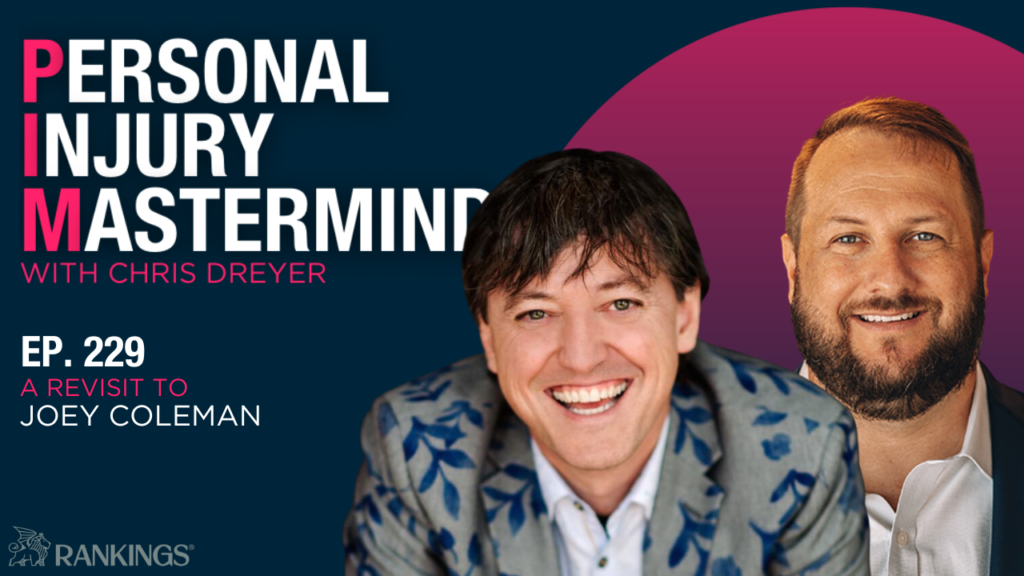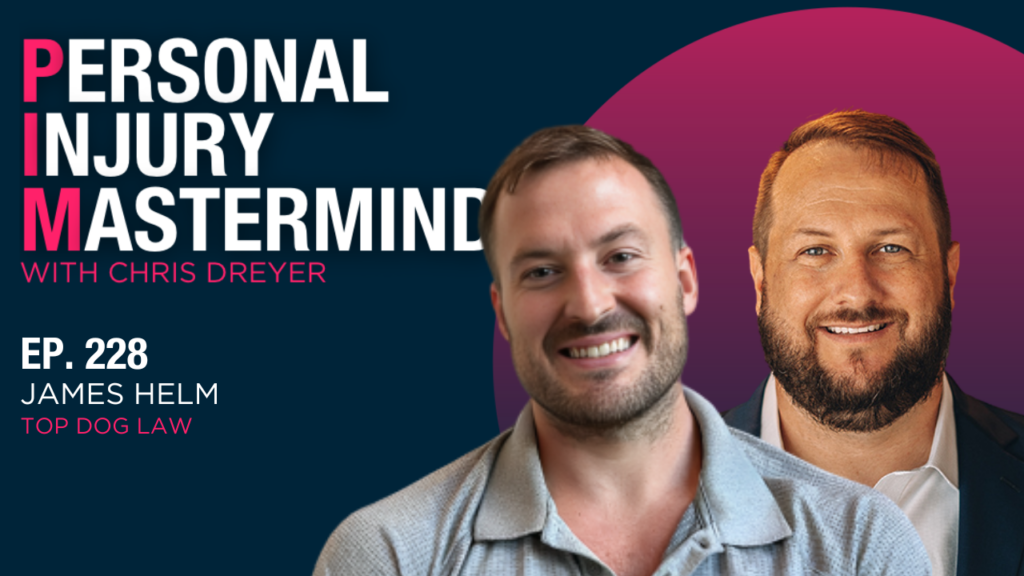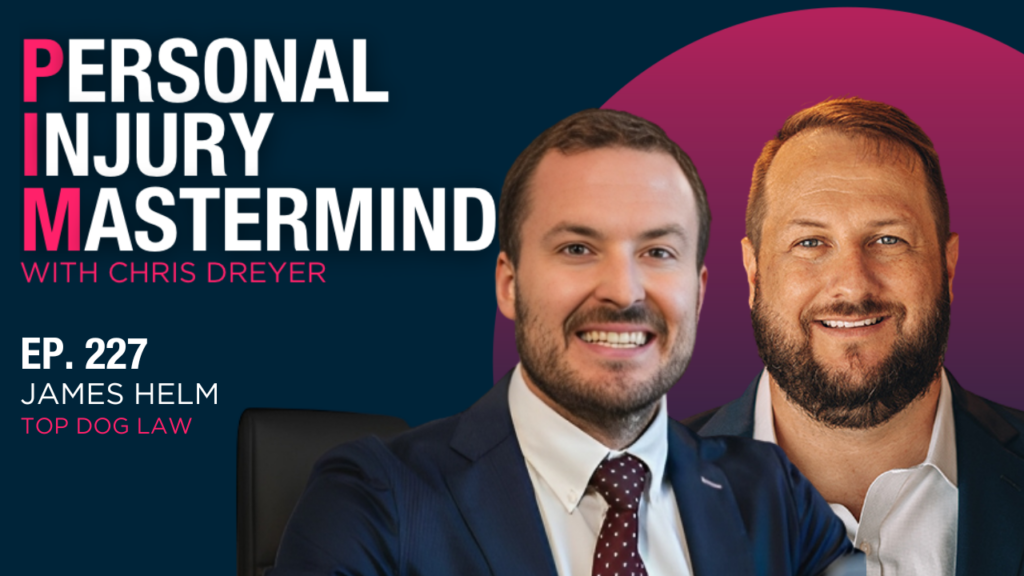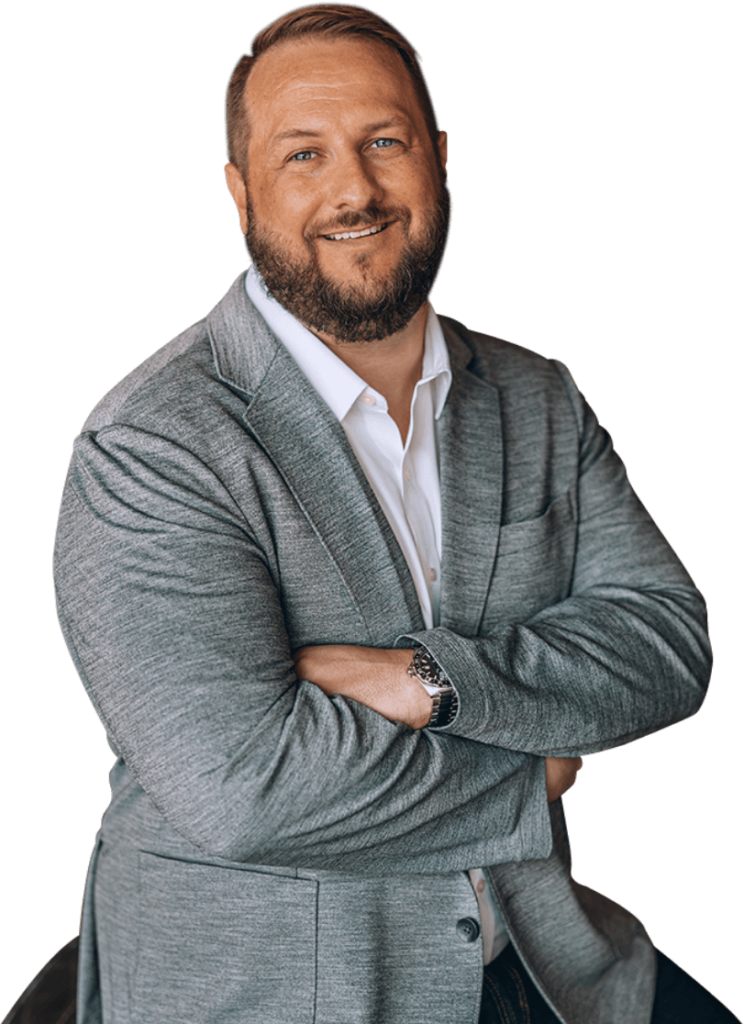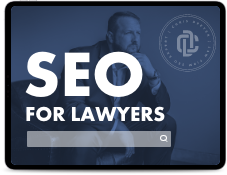Chris Dreyer
So when I say the word CRM, I usually get one or two reactions- attorneys either see tools like these as the necessary evil or they’re evangelists who tell you that the CRM changed their life. Today’s guest is from the latter camp. He experienced firsthand the power of process through the CRM case management systems and just managing people. And at every level of the law firm hierarchy, he’s got some pretty persuasive drivers that you’re going to want to know about.
William Denninger
And the reason why it’s getting more competitive, there’s more money in the marketplace. It’s harder to get cases and people are realizing you can make a lot more money without spending any more money.
Chris Dreyer
Today, we meet Bill Denninger, Director of Business Strategy at Weitz & Luxenberg, the biggest plaintiff’s law firm in New York. We hear how Bill transformed the firm’s processes in the perfect Venn diagram of people, process, and profit, which data sets the law firms of the future need to have a handle on, and why Bill believes you should always hire a geek.
That’s coming up on The Rankings Podcast, the show where founders, entrepreneurs, and elite personal injury attorneys share their inspiring stories about what they did to get to the top and what keeps them there. I’m Chris Dreyer, stay with us. It’s probably fair to say the position of Director of Business Strategy is a new development of many law firms and some of you might assume it’s only necessary for those huge scale market leaders. Bill’s been in the game for a while, however, and he’s seen where the industry is headed.
William Denninger
In my experience and working in law firms and speaking to a lot of other law firm owners, there’s a gap, right? Between, you know, the people that run the technology – which they always call the IT department, which drives me insane, right, because IT is a help desk, phones, my computer doesn’t turn on – and the lawyers. And they both know their areas really well, but they’re not speaking the same language. And really that’s been my focus for a long period of time of kind of bridging that gap. And then just normal business practices, budgeting, documenting how processes work right, and make them work the same way over and over. So you can train people in and out of positions using technology and automation in the way that every other business outside of law does and that’s been a major focus. And when I started at Weitz & Luxenberg, you know, I was one person. And since then I’ve grown it into a department of about 10 different people and we’re, you know, intimately involved in various aspects throughout the firm. And, you know, even to the point where the guy who I got hired, my second hire basically kicked me out of my job. So now I’m doing strategy while he really runs the operation.
Chris Dreyer
Yeah. And for one, I really appreciate the operation side of things because it lends itself to consistency. There’s nothing wrong when you get an inconsistent result, when you work with someone, I think that a lot of businesses that rule by abdication – “hey go do this for me”. And, then that individual leaves, it’s like, okay, well now I have to start all over. So have you found yourself when you’re implementing these ground up processes, did you start to see the foundation just really strengthen and see itself, have the ability to scale?
William Denninger
Yeah, and really it’s amazing how little people, you know, know about how their businesses operate, right. Especially in the firms. So they say, well, how does this work? One of the first things that we do as a group when we start a project is we sit down and we do current state and we interview the manager. We say, okay, how does it work? And then you talk to the person who’s actually doing it. They’re like, if I did it, it would never happen, I’d never get anything done. I can’t do all those things. I do it this way. And then you kind of take that, you meld it and you begin to kind of develop what’s the best possible scenario. And really it’s about, you know, increasing your productivity, controlling what’s happening in the firm, reducing your overall operating costs and increasing your profits. And I think one of the reasons why, and it’s a personal theory of mine, but I really believe that plaintiff law firms are so profitable is that they don’t have to have strict budget rules. They have the ability to run sloppy because it’s just there and they still make money. And that tide has changed and it has been a massive shift in the marketplace. I mean, it’s why you have all these, you know, there’s more case management systems. I mean, CRM was something that was never even spoken about five years ago. No one even knew what it was. I mean, I did my first year in building sugar, which was a free off the shelf application before we moved into Salesforce. Well, you know, it was running intake out of a case management system, which is a different data structure. So yeah, I mean, you know, it’s moving in the opposite direction and the reason why it’s getting more competitive, there’s more money in the marketplace. It’s harder to get cases and people are realizing you can make a lot more money without spending any more money.
Chris Dreyer
There’s so many nuggets there that I wanted to ask about and your Invoca YouTube interview, and I specifically wanted to focus on, so let’s nail down the difference between the case intake and their deficiencies versus the true use of a CRM from a business standpoint. And I think you, you nailed it in that interview and I’d just love for you to share with our audience kind of the differences there and the limitations.
William Denninger
So on a CRM system, which is really designed for intake, right? An intake system is I’m trying to get you the individual to do something. So, you become the most important piece of that record. So what do I mean by that? I got a web form submission in, I need to call you, I have a conversation with you, I send you a contract, right? All the next activities, the tasks, everything is all centered around the client. Once you sign the retainer, that is no longer the case. The main record now is, you know, Jones versus Geico or whatever, you know, whatever the lawsuit is. That becomes your parent record and the individual client hangs off of that. So it fundamentally changes your data structure. What’s the next step? I need to order medical records. I need to file a case. I need to know all of the steps as it goes down to the legal process is around the case and that client becomes tangential and just another party, just like the defendant attorney, the doctor that’s treating them, and so on and so forth. So, that’s a fundamental shift that really happened and for a long time, people struggled running call centers off of case management systems and that’s why is that your data wasn’t organized the proper way. And it’s true, even if you go through case management systems, a single event practice case management system data structure is different than a multi-district litigation or a mass tort, right? So understanding what tool you’re using for your practice and what areas of practice you operate in is crucial in deployment.
Chris Dreyer
Bill knows how challenging it can be to test and implement new CRM systems at law firms. At Weitz & Luxenberg, New York’s biggest plaintiff’s law firm, he completely re-imagined their case management systems. It was a transformational process on a massive scale, but many of the key processes that Bill executed could be applied to a firm of any size.
William Denninger
Well, I came in there, they were really running everything out of the case management system. They had sort of a CRM type interface within there that they built, but it wasn’t really robust. You know, and really comes down to for intake it’s customer service. It’s keeping it simple. Right? So, you know, who was the last person to speak to them? When was the last time they were contacted? You don’t make your client repeat themselves 15 times. You don’t call them 16 times in a day or not call them for 16 days. Right? That’s a major component. So it keeps all that information in once one spot. The other huge advantage of a CRM system if it’s set up properly is that a huge portion of a law firm’s budget is in marketing and client acquisition and keeping track of the lead attribution. How did this client get to you? Right? Was it Google AdWords? Was it your Facebook? Was it a combination? You know, how are you running through the funnel? A lot of firms, you know, operate transactionally in that they just put out, you know, a Google ad word where you hurt in a car accident. Yes. Click here. Bang. You’re in, you’re in. But, you know, in some of these other torts, you know, especially those in a lot of the drug cases, there’s an education process where you’re putting out content as it goes in. You’re not necessarily asking them to call, you’re educating the marketplace and the fact that, Hey, if you use Roundup, And you got an NHL non-Hodgkin’s lymphoma, there’s a link here, right? Which is exposure and injury. And sometimes in a car accident, it’s pretty obvious you got hit by a car, next thing you know, you wake up, you’re in a hospital, but in a lot of the drug cases, you have to educate the marketplace and say, hey, there is correlation here. That’s what this litigation is about. So, that’s the biggest payoff and usually that’s what’s the lowest hanging fruit when you walk into a law firm. It’s that, okay, how are you doing you’re marketing tracking? How are you doing your lead attribution? Because if I make your money, 10, 15, 20% more efficient, everything else I do is free, right? So that’s the other part. And then, you know, in the case management side, it’s about presenting the information to the lawyers as the only information that gets gathered all in one place, anyone can review it. The partners, the managing partners can keep track of all of their cases and understand what’s going on in their entire universe. The individual attorneys can see their case load, know what deadlines are coming up, what’s happening, how they can distribute their work. And then, you know, those two things operating together gets you to the kind of nirvana of a normal business, which is very simple, right. What’s your net profitability on a firm is a lot of referral relationships back and forth, but what’s the profitability on your referral relationship trips and doing budget forecasting for next year, right? Because you know, a case that comes in today, it’s an 18-24 months, depending upon what type of case it is in some cases, four or five years before you see that money. Right? So, understanding which areas of practice are profitable, which attorneys are profitable, where you can increase your profitability, capturing all that data, storing it in one place. It is really the foundation of getting that started.
Chris Dreyer
I couldn’t agree with all that. I agree more with all that. And there’s a saying that comes to mind. I’m know you’ve heard it that 50% of your marketing’s working, you just don’t know which half. Now, there’s as a couple of follow-ups specific to plaintiff, you know, and this is a little surf self-serving, but I know our audience will appreciate this, but typically the PI firm will have a vanity phone number: a 1-800 injured or something. I don’t know the exact character limit, but, you know, so what kind of challenges do you face in those situations when you can’t necessarily use a call rail dynamic pool or dedicate a specific phone number to a source? You know, do those lose value and, or, you know, what kind of, how do you overcome some of those challenges?
William Denninger
So I spent basically five years railing against vanity numbers. I hated them and I never understood them. I didn’t think they made sense. And then I became friends with some of the, you know, bigger motor vehicle accident attorneys who really, you know, push the vanity number and I begin and I began to recognize the value in, it makes a lot of sense, right? In that this, through repetition, they are, you know, drilling that phone number into your head so that this way, when that accident happens or when you do need the lawyer, it’s instantly there. But I think what you can do when, and what I’ve recommended a few different times is okay, that’s your branded marketplace, right? So that’s your budget for that. But you could try these other tactics, whether they be social media, whether they be long funnel education, whether they be community outreach, there’s a hundred different ways you can market and break it out of branding. Not everything has to have the vanity number on it, especially if you’re doing mobile device, right? No, one’s no, one’s typing the phone number and it’s clicked the dial. Right. Cause it’s all. So, in those scenarios, especially when in your digital marketing side, start using some call rail numbers or Invoca right. And see what’s effective and not effective. And then you can, you know, once you understand what’s working, what’s not working and it comes down to. I mean, it’s not just is the tactic working or what’s my cost per retain? I mean, we’ve done some research and working with our marketing people, like I forget one of the campaigns that we’re running, we figured out that if you just use a medical image, right, of like an x-ray and one of the ads at a 20% higher rate than other image, right? So, those are all the little experiments that you begin to play with, and you can translate that over into your branded, right? So you can play over here and do all your AB testing on one side without your vanity number, and then take your learnings and apply it for best practices into your branded campaign. So, you don’t have to just, you know, only use that phone number, you could play around a bit and I recommend it because the learnings that you get there increases the efficiency of your branded marketing.
Chris Dreyer
Yeah, that’s some great points. I always wondered that. And in terms of attribution, it’s easy to do the direct response bottom of the funnel, your paid ads when you’re bidding those bottom of the funnel keywords and things like that. I was just kind of curious from a brand perspective and also, you know, it’s just a challenge. I would say, you know, you’ve got your funnel, the top, you know, top of funnel, middle of the funnel, bottom of the funnel, or no light trust, whatever you want to call it and how you evaluate their effectiveness when it’s not that immediate return. And so I’m sure that’s a big component of having enough data, probably paints a different picture.
William Denninger
Yes. Um, and you know, it’s interesting, we’ve gone through the journey right. Where we started with the platforms, we moved into the platforms, and then we made all the platforms talk together and everyone, you know, everything had a place to go. Then we started building on the reporting on it and it was a very fast acceleration in the reporting side. And then we hit like a dead stop and it was, you know, why? Because the ability for people to interpret and understand the data that we were providing to them, we exceeded their learning. They didn’t understand what to do with the information we were telling them, because it was too much information. So there’s, so now we’re actually in a push and pull in between providing reporting and data and educating how, you know, what’s the history of that data, right? Where does it start? Where does it stop? How accurate is it? Are we capturing it or do we have to go back into the database and change the way we’re capturing a particular piece of information to make it, you know, a better reporting format? But also how to think about the business, right? We’ve come to the point in the last year, really, since we’ve made this huge portion to really making the data consumable where the attorneys themselves have had to change their decision-making process, you know, typically more around operational issues, but definitely how to spend money, how to assign out work, how to interpret that because they just have a lot more information that they’ve never had to deal with before. But the benefits are, you know, impressive.
Chris Dreyer
Yeah, and I imagine from the scaling component and choosing strategic partners to work with, whether it’s a media buying company or SEO or PPC or whoever, you know, traditional marketing, that there’s a more of an objective thing – “hey, here’s the data, you’re not getting it done. I like you, but we’re going to have to let you go type of situation”.
William Denninger
And it’s knowledge, right? So, you know, I’ve had some marketing companies that have long relationships with the firm and, and, you know, I sit down and I say, okay, I’m interested in, you know, running some marketing and investing in this litigation to see if we can get some cases, what’s your cost per retained? And then they tell me, and I’m like, I’m doing better, like, why should I go with you? And they would get frustrated, like we had a great relationship, blah, blah, blah. And I’m like, I’m saving $500 per case, sorry. I’m not going to spend the money with you just because we’re friends. I mean, if you can get your costs down, we’re there, but you know, standing what your numbers are. And again, it goes back to increasing your profitability, more efficient use of your capital. No one has unlimited budgets at the end of the day. It becomes a competitive advantage because if me and you are both going after that same case, and my money is 20 or 30% more effective than yours and we’re spending the same amount I’m going to beat you. And it’s compounding over time because I’m signing up more cases for you this year, which means I’m going to have more money next year to spend and so on and so forth. And I just keep on beating.
Chris Dreyer
So I got a lot of follow up questions for a personal injury firm. Let’s say that wants to get more focused or try to improve their attribution. What are kind of the foundational things that they should look at and trying to measure, you know, lead sourcing and things like that?
William Denninger
It starts with – hire a nerd, right. Hire someone. It actually starts before that. The first thing is make sure that you take someone whose job it is to work on the law firm, not for the law firm. Right? So, they don’t talk to clients and their job is singular in that they run marketing, they run data, they don’t have to come in and press a button every day. They’re project-based and they’re able to move, move these projects forward. The second thing is you have to assess who you have in the office, right. And you can’t expect the guy who, let’s say, is running a traditional IT department – so he’s setting up your phone system, making sure that the networks up all that to suddenly go and do web design and lead attribution – it’s not the same skillset. And,all right, yes, it’s technology, but it’s like saying anyone IT can do any area of practice. It’s not true. So figuring out that you have the people with the right skills, with the right mindset, right? The way they think the way to troubleshoot being creative in the right position. If you don’t find that person, if you don’t want to hire them directly, you know, you can outsource it for a period of time, but bring that knowledge in-house and then start going through your systems and understanding how you’re capturing the information store, creating plans, right. Process. It goes down to people, process, technology, right? So, do you have the right people in place? Do you have a process as defined and exactly how you’re going to capture it? For us, IT goes to the marketing department, IT goes to the accounting department, IT goes to the operations department. They’re all involved in the creation of a new campaign. And the legal team. So that this way we know where they’re coming from, how much we’re spending on them, linking everything all together and that’s what gives you the full scope picture. So, it requires people to work as a team and you got to have the unit, make sure you have the right skills in-house.
Chris Dreyer
So it’s truly that Venn diagram. So you don’t have the right people, but you got the process and the tech then, or you’re missing any of those components kind of sweet spot right in the middle. And this was working on the business with operations, attribution’s people, process technology, you know, is it a, because there has to be a fundamental awareness of this language and the type of individual they need to hire. Is it, do they need to explore a scaling up by Verne Harnish or is it a, you know, an EOS by Gino Wickman? You know, where should they start on this awareness of working on the business?
William Denninger
You know, in my mind, it always starts from the top down. Right. So, listen, I know a lot of great lawyers that are bad managers, and I know a lot of great managers that are bad lawyers, right?And some really great lawyers that ended up getting stuck in management roles because they’re competent and they don’t they’re resentful and they don’t like doing it. So it ends up being something that they just deal with it whenever they can. So it starts with a what’s the goal of the business, right? Who are the people here? And do I have, you know, the right people in the right places? And are they interested in doing this work? Because you’ll find a lot of attorneys that are like, Hey, you know what, I don’t really enjoy practicing anymore. And the person that loved practicing 10 years ago may not like practicing now, right? People change over time. Their lives change, their family, whatever outside influences. So making sure you have, you know, a clear direction of your firm, this is where I want to grow, this is the next area and then lining up your people, delivering the message. It’s just simple leadership and management all the way down the line. And if you have someone and I see this all the time, you know, oh, this person’s a department head, right, and they’re involved in like, you know, 10 major torts and Oh, by the way, they also have a staff of 100 that report to them that they have to supervise. In what reality is that going to happen in both places, right? And, by the way, management structure. Right? So there’s like two people between them and 85 people. It just doesn’t work. And I think that more and more law firms are beginning to kind of notice it. You gotta have a goal for the firm and our standard where you’re going, what your assets are and driving towards that initiative. But it’s changing. I mean, I’ve watched some of your podcasts and I’ve seen some of the attorneys really start to make that change and recognize that they can’t be in court 30 hours a week and run a business. You just, it just, you can’t do it.
Chris Dreyer
Yeah, it’s the delegate and elevate. You only have so much time, so you gotta, at some point you gotta bring on, I mean, tools and technology can help you very far, but at the end of the day, you got to maybe have more bodies at the firm to get it done too. Yep. Yeah. So switching over to personal so that you’ve worked on some really sizable projects and, you know, you’re clearly someone that loves a challenge. So, you know, are you go climb a mountain type of person? Or what do you do in your downtime? What do you do to kind of break away from work?
William Denninger
You know, I have a weird background in kind of how I got here, but at the end of the day, it’s fundamentally decision-making understanding complex systems and I’m still like that 15-year-old kid laying underneath my dad’s car, him telling me, you know, what to fix and walking away and coming back 20 minutes later and telling me what to do next. I spend a lot of time fiddling around my house, constructing cars, whatever it is, time with my family and cooking. But it’s that same thing, it’s decision-making, it’s complex problem solving, but just, I get to control everything and I don’t have to ask anyone’s permission besides my wife.
Chris Dreyer
I love that. Okay. So we’re going to, we’re going to close up with our three for three. It’s just three questions and three minutes kind of quick hitter at the end here. So number one, I know, you know, where this question is coming from. What is your top search engine optimization tip?
William Denninger
It’s content. I look at so many websites and they just, they don’t have the content to it. They don’t keep it up to date. They don’t keep it relevant. You know, that’s a big aspect and it’s hard. I mean, it’s really hard coming up with that creative over and over again, but you know, content content.
Chris Dreyer
Absolutely agree. Which entrepreneur do you admire the most?
William Denninger
Ooh, that’s a tough one. I read a lot of biographies. Rockerfeller, Musk. It’s a combination. I don’t know if I, I don’t know if I could just pick one there’s certain aspects of each one that I liked.
Chris Dreyer
I have to ask a follow-up and I’m probably not supposed to do this, but did, did you read Titan? That’s like one on my to read. Yeah,
William Denninger
it was fantastic. Actually. I just recommended it
Chris Dreyer
Really? I got to read it. Okay. And then final question here, which of the one book which book has had the biggest impact on your life to date?
William Denninger
Good to Great, Jack Welch.
Chris Dreyer
Some superb lessons and process-driven management from Bill Denninger there. I think a lot of you listening out there and PI firms can relate to the shift in perspective that’s going on at the moment. The law firm of the future is anyone’s game right now and innovative business strategists like Bill have a huge part to play in where the industry is headed. You’ve been listening to The Rankings Podcast, I’m Chris Dreyer. A huge thanks to Bill Denninger for talking with us today. You can find more info, as always, in the show notes. And we want to hear from you. Has Bill got you looking at your marketing attribution in a whole new light? Drop us a review and let us know. Thanks for listening. We’ll see you next time.




